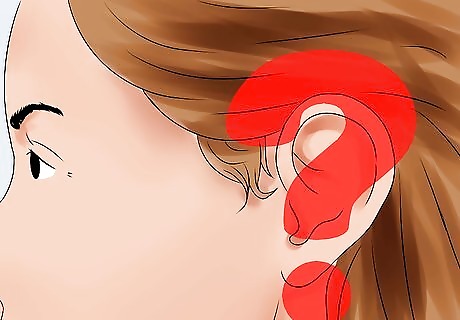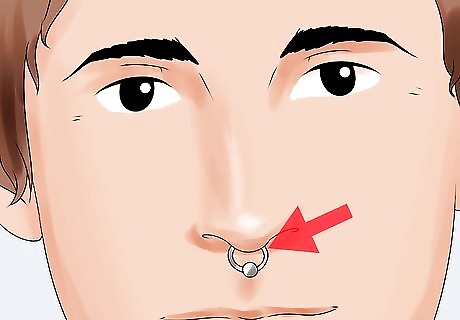
views
Brainstorming

Consider the visibility of the piercing. Ear and facial piercings are very visible, which can cause problems at school or work for some people. If you're thinking about getting a piercing, make sure you won't have to take it out at school or at your job. If you're set on getting one, give some thought to covering your piercing in the meantime. Sometimes, schools will allow piercings to be covered with a small bandage while it heals.

Use a temporary piercing. Temporary rings can be gently clipped onto the place you're considering piercing, allowing you to get used to the sight. If you don't have a clip-on piercing, you can use a small sticker-backed bead, or small plastic jewel and stick it to your face with non-toxic white glue. It might seem silly, but you can look at yourself in the mirror from different angles. Go out in public if you want. Get other peoples' opinions. Keep looking at yourself in the mirror throughout the day in different lighting. At the end of the day, did you ever have any doubts about the placement? If so, you can always do this step again.

Take a picture. Take a picture of yourself from the front and from different sides. See how it looks. Upload it online to see what your friends think. Make sure that it shows your whole face, head-on, in good lighting. Upload the picture to an image editor. It can be as simple as Paint or you can use an advanced editor like Photoshop, or you can use an online editor like pixlr.com. Place a black dot (or a picture of a ring or stud) on your face to represent the piercing, if you don't have a clip-on. Step back from your computer and look at it. Adjust the placement until you have a good idea of where you want it. Experiment.

Think about your flaws. As backwards as it may sound, you an use piercings to distract or augment certain things you might think of as flaws. For example, a bumpy or squat nose can easily be covered up with a nostril piercing. Don't like the shape of your brow? Try adding a ring, or drawing attention to other parts of your face, with a lip piercing.

Sleep on it. Don't make any snap decisions. Take a couple weeks to think about it. Keep trying on your fake piercings and making sure you like how it looks. Think about how much work it will take to keep clean. Make sure you really want it.

Consult an experienced APP-certified piercer. The best person to talk to about any of your piercing questions and concerns is a piercer certified with the Association of Professional Piercers (APP), who are required to attend at least a year-long apprenticeship program, and stay up to date on blood borne pathogen safety. When you get pierced, make sure you get pierced by a professional.

Talk to your parents, if necessary. You may need to acquire your parents' consent before you get any part of your body pierced. In some areas, you can be 16 and get pierced without consent, while other areas require you to be 18 to get a piercing. In some areas, you must be at least 14 to get pierced, with or without your parents' consent.
Piercing Your Ears

Consider a basic lobe piercing. Ear piercings are the most common type of body piercing. You'll see pierced ears at church and at a punk rock concert. Most schools and jobs allow pierced ears, but they can also be covered with hairstyles quite easily. Pros: Stylish and simple, a basic ear-lobe piercing is a good intro. If you want something a little more wild, you can get your lobes pierced multiple times, or stretch your piercings with gauges after they heal. Cons: Lobe piercings aren't the most exciting choice, if you're looking for something a little more "out there." Still, it is a good introduction.

Consider a helix cartilage piercing. The cartilage high on your ear is commonly pierced, versatile, and relatively painless. This area of the ear makes for an excellent and trendy piercing option. Pros: You're piercing through thin cartilage, and helix piercings are relatively simple and easy to clean. It's also versatile enough to connect to other piercings, though it stands out from a traditional lobe piercing. You can pierce the helix or the antihelix, slightly lower on the ear. Cons: This piercing sticks out a little more on your face, though it is easy to cover with certain hairstyles.

Mix it up with a tragus piercing. The tragus is the cartilage in front of the ear canal, which partially covers it like a small flap. While this is a somewhat difficult piercing, it stands out a lot and offers a unique piercing option. Pros: This advanced piercing stands out from the crowd. A small, tasteful stud or ring in the tragus can be a big statement. It's also a little painful, which can be a good way to show off your tolerance. Cons: Because the cartilage is a little thicker than the top of the ear, this piercing hurts. Tragus earrings are also susceptible to wax build up, making frequent cleaning a necessity. This piercing can also be somewhat uncomfortable when wearing headphones, especially ear-buds. The fold just about the tragus is the "daith," which is usually a little easier and less painful to pierce, but looks quite similar to the tragus piercing. Think about a daith, if you're concerned about the pain and aftercare.

Consider a conch. Conch piercings go between the helix and the lobe, along the back ridge of your ear. These make for another common ear piercing. Pros: Like any ear piercing, the conch is relatively safe, quick to heal, and generally easy to care for compared to facial or body piercings. It looks great with bar-style piercings. Cons: This is one of the more big-statement ear piercings. You'll definitely notice it.

Consider other cartilage piercings. There are lots of cartilage folds in the ear, and most of them have been pierced at one time or another successfully, by experienced and licensed piercers at tattoo parlors. If you want to get your ears pierced, get a temporary ring that you can clip onto different parts of your ear to experiment. Leave it there for a day or two and see how much you like it, then talk to the piercer for advice. EXPERT TIP Karissa Sanford Karissa Sanford Body Piercing Specialist Karissa Sanford is the Co-owner of Make Me Holey Body Piercing, a piercing studio based in the San Francisco Bay Area that specializes in safe and friendly body piercing. Karissa has over 10 years of piercing experience and is a member of the Association of Professional Piercers (APP). Karissa Sanford Karissa Sanford Body Piercing Specialist What piercings look good together? Karissa Sanford, a body piercing specialist, explains: "Putting together different piercings can look like a hodge-podge, but with the right jewelry, a group of piercings can flow together nicely. The right jewelry could make it look normal and charming. You should try to find jewelry for each piercing that complements each other."
Getting a Facial Piercing

Consider a nostril piercing. Perhaps the most common facial piercing aside from the ears is the nostril. It's a stylish and increasingly well-accepted facial piercing in most communities, amenable for both studs and rings. Pros: Nostril piercings are much more common than they used to be, making them a good foray into a facial piercing. They're easy to care for and relatively quick to heal. Cons: It's mostly impossible to hide a nostril piercing, and you won't be able to take it out for several months while it heals. Corkscrew-style studs are also somewhat difficult to remove.

Consider a septum piercing. The septum is the center wall that separates your nostrils, just under the cartilage. The septum is an increasingly popular choice for a variety of reasons. Pros: Septum piercings are very versatile and easy to hide. Rings can be twisted up into the nostrils to make them practically invisible. Cons: Septum piercings look really stylish with the right jewelry, but can look a lot like boogers with the wrong choices. It's also sometimes a painful piercing, depending on the make-up and size of your septum.

Think about a lip piercing. Typically, the lip is pierced just below the lip-line of the bottom lip, in the middle, to the left or right side, or some combination. The top lip is also sometimes pierced, which is called a "Madonna" to one side and a "Monroe" to the other. Whether solo or combination, lip piercings are both hip and very common. Pros: There are lots of combinations and variations of lip piercings, which means you can start with one and evolve your piercings as you grow. If you want to end up with snakebites, or fangs, you can try out a single piercing and see how it works for you, then go back for more. Cons: Any lip piercing comes with some measure of dental risk, including chipped teeth and enamel wear. Like any facial piercing, lip piercings need to be performed by safe and experienced piercers.

Consider getting your eyebrow pierced. Eyebrow piercing used to be completed to show courage and virility. It's a punky and stylish selection. Pros: Eyebrow piercings are powerful and commanding in their presence. Both bars and rings look cool on the eyebrow. Cons: These are possibly the most difficult piercings to hide, and can't usually be hidden without removal or using a bandage. They're also somewhat less popular than they once were.

Think about a tongue piercing. Tongue piercings are a more advanced type of facial piercing that some people choose to work up to when they're ready. It's not usually a first piercing, but tongue piercings are popular for a variety of reasons. Pros: For some people, tongue piercings offer both style and sexual advantages. They're also easy to conceal. Cons: Tongue piercings are one of the more dangerous and painful facial piercings you can get. There is some risk of nerve damage and vascular damage, if piercings aren't done by a professional. They also bring some danger of dental problems.
Piercing Other Parts of Your Body

Consider piercing your naval. One of the more common and easily concealed body piercings is the naval, or bellybutton. Probably more common for women, bellybutton piercings typically look best on fairly trim figures. Pros: Bellybutton piercings are definitely the most common and socially acceptable body piercing. Cons: These piercings are typically somewhat painful, and require lots of aftercare to keep them healthy.

Consider piercing your nipple(s). Supposedly, Roman soldiers used to pierce their nipples to show their bravery. For both men and women, nipple piercings are a common and sexy body piercing. Pros: Many people like the stimulation and added sexual benefits of nipple piercings. They're easy to hide and quite trendy. Cons: The nipples are extremely sensitive, and the piercing can be quite painful and sore in the short term. Long term, piercings may also affect milk production and the ability of some women to breastfeed.

Consider surface piercings. The hips, the back, the nape of the neck, and the wrist have all been pierced at one time or another. Corset-style piercings are popular among body-mod enthusiasts and people looking for something different. Pros: These are the most eye-catching and spectacular types of body piercing, because of the difficulty of pulling them off. Piercing designs can also be made on the surfaces of the skin. Cons: These piercings are usually quite advanced, and are prone to rejection. They can also easily rip out of the skin if you make any wrong movements.

Consider getting your genitals pierced. For some advanced piercing enthusiasts, genital piercing is the biggest thrill and the most stimulating experience that piercing offers. For others, it's a terrifying prospect. While piercing can offer added stimulation and excitement sexually, it can also come with the risk of infection, permanent nerve damage, and a loss of feeling in your most private parts. Always consult with an experienced and licensed piercer to get your genitals pierced. Women often get a vertical clitoral hood piercing, although a horizontal piercing can also be performed. While other types of genital piercings exist such as a fourchette, done to the rear rim of the vulva, or the clitoris itself, many women do not have the anatomy required for these piercings or, like the clitoris piercing, they carry a considerable amount of risk. Men typically pierce the underside of the frenulum, through the urethra, or pierce across the head of the penis to complete a "Prince Albert." Other piercings exist such as the hafada, performed on the scrotum, or a foreskin piercing. However, the piercer will have to evaluate the anatomy of each individual, as certain factors such as whether or not the penis is circumcised can play an important role in whether or not the piercing can be performed.
















Comments
0 comment